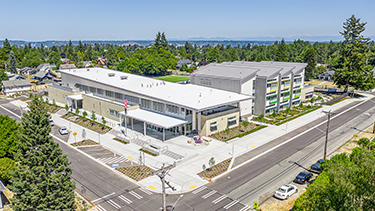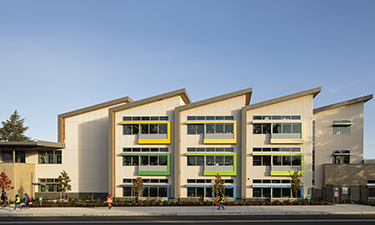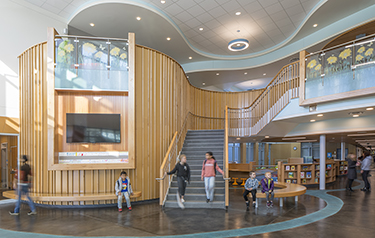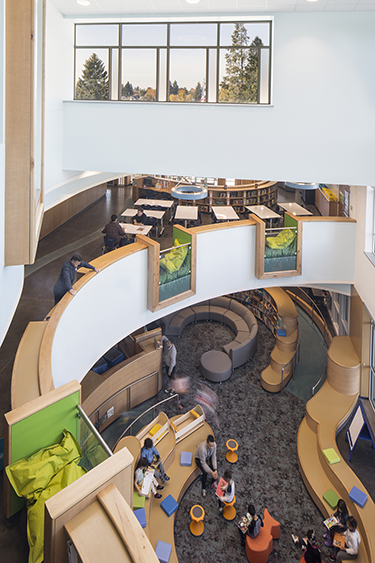|
Subscribe / Renew |
|
|
Contact Us |
|
| ► Subscribe to our Free Weekly Newsletter | |
| home | Welcome, sign in or click here to subscribe. | login |
Construction
| |
 |
August 27, 2020
Community engagement drives design for Tacoma school
IBI Group

Parker
|
What happens when you ask a historically underserved community to “dream big” for their new school? What if you then take those big ideas and community needs and combine them, with a goal of creating an inclusive and empathetic school with strong connections to nature? If you do it right, you get the new, reimagined Mary Lyon Elementary School — a unique building which serves its community in a refreshing way.
This new replacement school in southeast Tacoma is a three-story, 56,625-square-foot facility that serves 450 students in pre-K through fifth grade. Its design was driven by community outreach and extensive input from students, teachers, staff and parents from pre-design through construction. Careful study of student activities and locations was undertaken during pre-design to ensure the school would reflect where students actually spend the majority of their time — and where staff intend them to spend their time — in or adjacent to their classroom. The result was a learner-centered design for next-generation learners.
The school is embedded in a community which is long underserved by amenities like neighborhood parks, services or shopping, and is surrounded by one- and two-story houses. Both the school and community wanted to maximize outdoor play and learning spaces for students on the small 3-acre site, dictating a three-story configuration closely fronting two sidewalks. Most vehicular traffic is on-street, with separate street frontages for visitor parking, school buses, and parents’ loading and drop off. Generous canopies provide shelter at both street and playground entries to offer a welcoming gesture to the community while supporting the longstanding ritual of personal hand-offs of students between parents and teachers.
At the heart of the school is an open library atrium, serving three learning neighborhoods. Each neighborhood has six classrooms and two group meeting rooms. Each neighborhood includes a central, open learning area that supports hands-on activities and where art and science can occur on display for all. Each of the spaces is interconnected with flexible and transparent glass walls to foster collaboration, inspiration and supervision.
The learner-centered design started by locating student support spaces — library, counseling, tutoring, specialized instruction and administration — near to where students spend most of their time, in the learning neighborhoods. This close adjacency, extensive transparency, and minimization of corridors help to minimize stigma of students having to leave their classroom and cohort.
Safety is embedded throughout the design with the following features:
• Student outdoor areas sheltered from the street behind the building.
• Controlled entry vestibules lead to the receptionist, who has clear visibility into each wing of the school, each of which can be isolated at the touch of a button.
• Learning neighborhoods create student populations of a size where every student is known by all in their cohort to monitor changes in behavior and academic performance.
• Secured playgrounds help to contain autism students in the event that they run away uncontrollably.
Key to the curriculum, to an inspiration for travel and creating an empathetic worldview and to instilling a sense of environmental responsibility, is the school’s embedding themes and connections to the natural environment. A design theme of “Sea to Sky” incorporates elements from around the Puget Sound region (about a third of the students were reported to have never seen), including native plants, views, natural materials, colors, an outdoor learning deck with student planters, rain gardens, environmental graphics, and illustrative text in unexpected locations.
A celebration of water is used to highlight this connection, beginning with kinetic artwork that provides an interactive experience using rainwater near the main entry. From here extends a visual “watercourse,” a curving sandblasted and blue-stained concrete surface that winds its way through the entry and to all main areas of the school, including the recessed “tidal pool” built-in seating area in the library. Textured wood panels with raised dowels invite occupants to climb through the stairs through the forest canopy at the second floor. Curved ceiling forms mimic cloud formations in the daylight-filled interior. Nature-themed accent colors reinforce the progression from sea (blue), to forest (green) and to sky (sunshine yellow).
Passive sustainability is also incorporated throughout the design, including a large south-facing solar-ready roof, north- and south-oriented learning spaces for natural daylight control, vertical sunshades on the east- and west-facing windows, and daylighting of rainwater from downspouts discharging into the sidewalk-fronting rain gardens.
Personalization and flexibility of engagement of spaces is provided by extensive use of magnetic and writable wall surfaces in student collaboration areas. Individual scale is supported with small nooks in the library railings and seating areas, and window benches in each classroom with accent colors individualized to each floor and each classroom. The folding walls in each classroom support team teaching and multi-class collaboration.
On the main level, a vertically folding wall opens and closes to provide a large community space or separate the gym and lunchroom. The school requested that outdoor covered circulation be provided to connect to the lunchroom and gym so that the space saved could be used to create a community living room — a flexible, joint school-community space between the library and the gym.
The exterior’s expressive form responds to the residential neighborhood with a sloping roof at the classroom wing, breaking down of vertical and horizontal scale, and providing a welcoming street-front presence with a user-friendly entry plaza. Natural materials and bright colors infuse both nature and the community’s vibrant culture in a celebration of community pride.
Ross Parker is IBI Group associate principal and Seattle education practice lead.
Other Stories:
- Building schools is about building communities
- Learning inside and outside the box
- First U.S. net zero school has 10-year checkup
- How the pandemic can change education for the better
- Eastside school’s HVAC system zaps the bad stuff
- Idaho school master plan takes on Living Building Challenge
- Modular classrooms are a quick study in filling vital needs
- Modified mechanical systems for healthier schools
- Students get a boost from outdoor connections
- UWT project focuses on equity, justice and design






